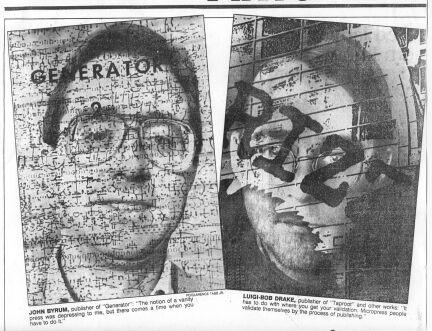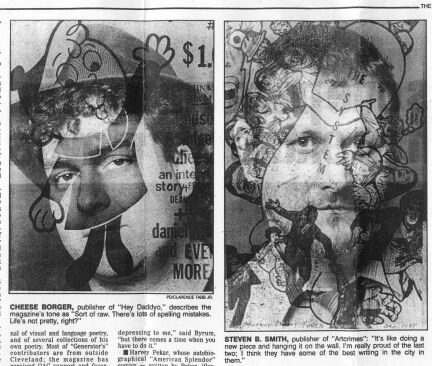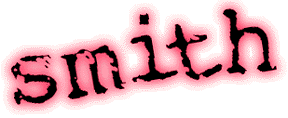
|
In Their Own Voices Rebecca Freligh The Plain Dealer April 2, 1989 See, there are these people out there you might not know about - people just like you - and they're making pictures and writing about everything under the sun and outside the galaxy and inside themselves, and they want other people to see their stuff, and it'd be real nice if someone would give them a million dollars for it, but no one will, not even close, so you know what? They publish it themselves. This genre - these uncommon works that don't come from big New York publishers owned by chain department stores, or even presses owned by universities - has been called by several names, though none quite fit. Here are some names that work OK: micropress (which, for convenience, we'll use here); self-publishing (though many micropublishers also publish others' work); very small press; zines (as in magazines). Here are some inaccurate or incomplete names, so don't use 'em: underground; alternative; small press; fanzine. Micropress can be handwritten, photocopied, offset, published on a desk top. It can appear in color or black-and-white, print or pictures (collage, drawing, photo, you name it), poetry or prose, book or pamphlet or cassette tape or tiny poems in a can. The common thread is the publisher's attitude. "For me and for people I know, it has to do with where you get your validation," says Cleveland writer and publisher Luigi-Bob Drake. "People who have what I think of as a small-press mentality want someone else to say 'Yeah, that's good.' Micropress people validate themselves by the process of publishing." Added Mike Gunderloy of Rensselaer, N.Y., writer/publisher of "Factsheet Five," which publishes reviews of micropress and is known as the bible of the genre: "They don't make any money. So the people who do it have to be doing it because they love what they're doing." As it happens, self- and small-press publishing is an honorable literary practice, at least in retrospect, which is how these things generally work. Walt Whitman self-published "Leaves of Grass"; Edgar Allen Poe self-published his "Poems"; and Lawrence Ferlinghetti's City Lights Books published "Howl," by Allen Ginsberg, to cite a few examples. In Cleveland, the late poet d.a. levy is probably the best-known publisher of his own work. Writing in the 1960s, levy was part of a nationwide surge of grass-roots publishing; some small presses that started up then have since become part of the literary establishment. The most recent wave of micropress activity owes much to the technology of the last decade or so: primarily, to machines that turn out cheaper, faster and clearer photocopies than ever before, insuring broad access to the medium. Distribution of micropress likewise takes place along alternative lines: "It's hard to find stores that will take stuff like that," said Cleveland writer Randy Russell. Only a few local bookstores, including Mac's backs, Old Erie St. Bookstore, and Bookstore on W. 25th St., offer micropress for sale around here, and it's even less likely to be found in smaller cities. Russell, like most micropublishers reviewed in "Factsheet Five," finds the Gunderloy publication the best way to expand his audience. Gunderloy, 29, compiled his first reviews in 1982 on a couple of dittoed pages and mailed them to other micropublishing friends. Today "Factsheet Five" has a circulation of 4,000, with subscribers on every continent save Antartica, and was the subject of a recent article in "Penthouse" magazine. Gunderloy has reviewed as many as 800 micropublications for one issue of "Factsheet Five." He listed just a few examples of micropress' dozens of interest groups: science-fiction fans; comics buffs; religiosos of all sorts; anarchists, leftists and radicals; beer drinkers; pornographers; hatemongers; and singles. "Almost anything you can find in a mass circulation magazine, you can find in a very small press," said Gunderloy. That's right, almost, he said: "News magazines just don't make it." These groups, according to Drake, are equal networks of publishers and contributors quite unlike the traditional publishing hierarchy. You publish their stuff; they publish your stuff. Some of your network may live in your city and may be well known to you; others you may know only through mail contact. As for official imprimatur via funding, the Ohio Arts Council supports "small literary publishing ventures" but does not support self-publishing, according to Robert Fox, OAC literature coordinator. In other words, Fox said, publishers may include their work with others' and be eligible for OAC funding, but can't get funds to publish their work alone. Publishers' attitudes toward institutional support vary. In the 1970s, Geoffrey Singer was adamantly opposed to funding for the "Cleveland Anthology": "I wanted to show it could be done without the help and the outside stamp of an agency." Cleveland writer Charlotte Pressler still feels that bureaucratic validation "will serve to focus and direct and channel, as usual," while Steven B. Smith, publisher of "ArtCrimes," said, "If I got funding, I could do more color covers." Locally the most energetic, sustained micropublished work has been done by poets and visual artists, though there are also music, comic-book and science-fiction writers/publishers busy here. A few names and projects follow: Drake, whose Burning Press is "actually a little light table, a couple of razor blades and the books I haven't sold yet." He has published 23 books, including 10 issues of "Taproot." While many of Drake's projects encompass both the literary and visual elements, he considers himself a language-based micropublisher. Smith, who published the first of six "ArtCrimes" art/literary magazines in 1986 because, "I'm an artist and a poet, and every other book I've seen around here is one way or the other. It seemed natural to get them together in one book." Each issue of "ArtCrimes" is different with respect to design, approach, size and contributors, who include some of the area's best-known visual artists and poets. Several ArtCrimes issues are planned for this year. John Byrum, publisher of "Generator," an international journal of visual and language poetry, and of several collections of his own poetry. Most of "Generator's" contributors are from outside Cleveland; the magazine has received OAC support and favorable reviews. "The notion of a vanity press was depressing to me," said Byrum, "but there comes a time when you have to do it." Harvey Pekar, whose autobiographical "American Splendor" comics - written by Pekar, illustrated by various artists - have gained him a nationwide cult following, not to mention guest appearances on TV's "Late Night with David Letterman." Cheese Borger, publisher of "Hey Daddyo," a bi-annual magazine of short stories and poetry which - according to a Gunderloy review - "goes in for the sort of nastiness that floats to the top in all of us from time to time." Borger says the magazine's raw tone and gritty realism reflect his admiration for writer Charles Bukowski, while granting, "I think I'm a little happier than he is." Singer, a poet whose Pranayama Press published the Cleveland Anthology in 1983, as well as small collections by individual poets. Last June, Singer, poet Mark Hopkins and Suzanne De Gaetano, a partner in Mac's Backs, published the first issue of the Coventry Reader, a free literary magazine in a newspaper tabloid format. Reader and advertising response has been enthusiastic, Singer said, and both the Reader's size and circulation will be expanded in forthcoming issues. Bob Sheridan, who with partner Bob Vaughn is writer/illustrator of the underground comic "Poot!" as well as smaller comics and "An Illustrated Guide to the Cleveland Bar Scene." Sheridan, who aims to illustrate underground comics, regards his venture as "a practice playground" with complete freedom: "It's like, go wild. You're doing it for yourself; you can do what you want." Christopher Franke, a poet who has published his own work in a variety of formats since 1970: broadsides, chapbooks (small books of poetry) of all sizes, postcards and what he calls "poem-collage leaflets." The pun-loving Franke publishes under the name "Deciduous Press," a sly wink at Evergreen Press: "Deciduous trees lose their leaves; I distribute my leaves," Franke said. Robert Ritchie, whose "Clevebland Rag-o-zeen" has been published occasionally since 1982, with another planned for this spring. Early Rag-o-zeens were written pseudonymously by Ritchie; later issues feature contributions from other local artists and writers. "It's Neo-Dada," Ritchie explained. "I think of it more as a humor-type thing than a political thing." Martha McCracken, Tim Argie, Elizabeth Petras and Gabriel Torvanche, co-editors/publishers of "Urban Voodoo," all students or ex-students in Cleveland State University's English department. Billed as "industrial-strength literature" and now in its second year, the magazine aims to be a forum for previously unpublished poets and fiction writers, while eschewing "sanitized fiction": "We like to say we will publish almost anything experimental," McCracken said. Randy Russell, who published "The Sweet Ride" ("The Rock 'n' Roll Magazine") for several years and has also self-published a novel ("Universe City"), short stories and other projects including "American Job," a collection of stories about work by a group of invited contributors. Why Russell does micropublishing is impossible to answer, he said: "Once I started it, it was hard to get away from. It's kind of addictive; it's hard to imagine not doing it now." 
|

